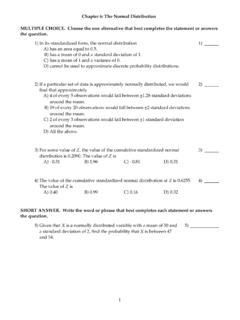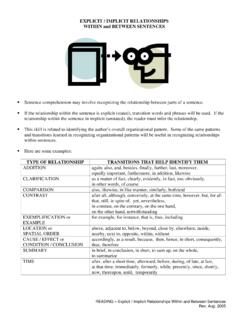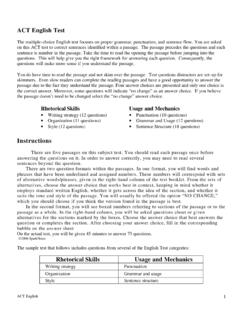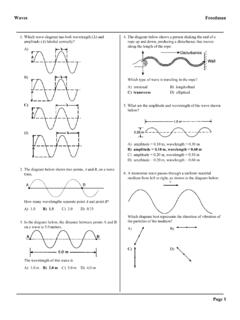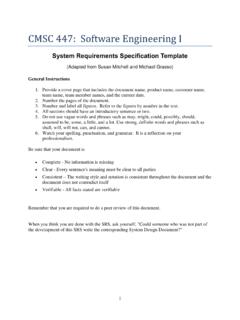Transcription of How-To Templates - IUPUI
1 Individuals with an ASD sometimes have difficulties with sequential processing ( , learning the order of events). These difficulties with sequential processing may results in individuals becoming anxious or overwhelmed in certain situations, which in turn may lead to problem behaviors. In contrast, individuals with ASDs often have strengths in visual processing. As a result of this strength, the use of visual schedules can help the individual better understand expectations, thus reducing the likelihood of negative visual schedule is a line of pictures, objects, or words that represent each major transi-tion during the day. Some people worry that by adding a schedule to an individual s day, it reduces the individual s ability to be flexible.
2 In reality, the opposite is true. By implementing a visual schedule, individuals generally are less dependent on having the same daily routine ongoing because the schedule itself provides the stability and routine s/he needs. Individuals can better handle changes to routine when they have schedules because they know that, regardless of the precise activities reflected, they can always determine what will happen next and get information by checking their are a variety of visual schedule formats available. Individuals should always be ac-tively involved in monitoring his/her schedule ( , peel off completed activities, check off boxes for activities). There are a variety of activity schedule formats available ( , picture, word, pull-off, check off).
3 For details on each format, refer to the information for visual schedules on this website. How Do I Make a Visual Schedule?1. Break the individual s day into several steps represented by pictures or words2. Be conscious of details (include even minor steps as needed for the individual)3. Represent each activity so the individual knows what is expected (even periods like free time and break)4. Determine the best visual format for the individual based on skills (motor, reading, at-tention to detail, etc.), developmental level, interests, distractibility, and functionality5. Determine how the schedule will be used to indicate which activities are complet-ed and which remain to be done as well as how the individuals will transition to and from the schedule ( , transition strips, transition pockets, finished pockets on schedule, mobile schedules)6.
4 Added details in making these format decisions are provided below in the sections regarding specific types of SchedulesMaterials provided are samples only! They may need to be individualized to meet the particular needs of a person with an ASD! How-To TemplatesChristian Sarkine Autism Treatment CenterIU School of MedicineAlso, check Video: First-Then BoardHow-To Template: Activity ScheduleHow-To Template: First-Then BoardKid s Corner Series: Life with ASD SeriesAcademia SeriesStrategies in Practice SeriesView/download these and other Templates at (317)274-2675 Fesler Hall ( IUPUI )1120 South Dr., Ste. 302 Indianapolis, IN 46202 How-To Template: Visual SchedulesHANDS in and Presentations of Visual SchedulesHow to Use a Visual Schedule1.
5 Give a standard phrase ( , Check schedule )2. Prompt the individual (from behind) to go to the schedule3. Prompt the individual to look at or point to the first activity 4. Prompt the individual to go to the location of the first activity 5. When the activity is over, give the standard phrase again and prompt the individual back to the scheduleWhen using the schedule, remember the following steps:Remember!The schedule will require teaching; it will not automatically have meaning. Use enough prompting to ensure the child gets there, but fade out slowly so s/he goes to the schedule with increasing independence. If you cannot fit the individual s entire day on the schedule (or if the individual does better with less information at a time), it is fine to simply put up part of the day.
6 While s/he is engaged in one of the last activities on the schedule, you can arrange the schedule to include the next part of the day or have it ready on another board for putting up once the first section is SchedulesIn a picture schedule, the activities are illus-trated through picture icons or photographs. Each picture is attached to a schedule board with Velcro, and the pictures are removed as activities are completed. For some individuals, it is most appropriate to have them check their schedule, complete the activity, and then re-turn to the schedule to remove the picture (into an envelope or box next to the schedule) to indicate the activity is complete. The individual then checks the next item on the schedule and continues in that manner.
7 Others do better when they check their schedule and then take the pic-ture card to the area where their next activity will occur. This process helps the individual remain focused on where s/he is supposed to be going. In this variation, envelopes or boxes must be next to each area where activities might occur ( , a bathroom, kitchen or bedroom at home; a play area, work area, and reading area at school) for pictures to be deposited in or have a matching picture to Velcro to in the activity schedules may be arranged verti-cally or horizontally. A general rule of thumb is to use a vertical schedule ( , top to bottom) for pre-readers and a horizontal ( , left to right) schedule for FormatFollow us on Facebook, Twitter, YouTube, & Learning Connections How-To Template: Visual SchedulesHANDS in AutismThe use of Velcro to attach words or pictures to a schedule is a helpful method for some individuals.
8 The process makes it easy to focus on which activity is next, because all prior activities have been removed from the SchedulesObject SchedulesFor some individuals, pictures or photographs may be too abstract. If the indi-vidual needs a more concrete indication of activities, an object schedule can be implemented. In such a system, each activity is represented by a concrete ob-ject easily associated with the activity ( , a fork for lunch, a block for playtime, a pen for work time) or to be functionally utilized in the next activity ( , Lego to be utilized in playing Legos). The objects can be arranged in a row from first to last, indicating the order of activities and can be manipulated as represented above for picture SchedulesAs individuals become stronger readers, it can be appropriate to use words to represent activities, rather than pictures or photographs.
9 If an individual has been on a picture schedule previously, it may help to fade the pictures out and the words in. Specifically, begin print-ing words on the picture schedule cards and, over time, increase the size of the words while decreasing the size of the picture. This process will help the individual begin to focus more on the written word than on the image. Although the use of Velcro highlights which activities are remaining on the schedule (by removing completed activities), other schedule formats may be more appropriate for certain individuals. In a check off schedule, all activities are listed on a piece of paper. Depending upon the reading level of the individual, it may be appropriate to use pictures, words, or a combination of the two to repre-sent activities.
10 A square should be next to each activity so the individual can check off activities as s/he completes them. This format allows the individual to see what s/he has already com-pleted as well as see what remains to be done. Other variations of this schedule could include schedules written on a dry erase board or a cross off schedule in which the individual crosses off items completed in order on his/her sheet. This format can be distracting for some indi-viduals, however, so it is not always the most appropriate format to SchedulesSchedule PresentationHow-To Template: Visual SchedulesHANDS in all the above schedules, the schedule is located in a specified space and the individual returns to that place between each activity to check the schedule.
